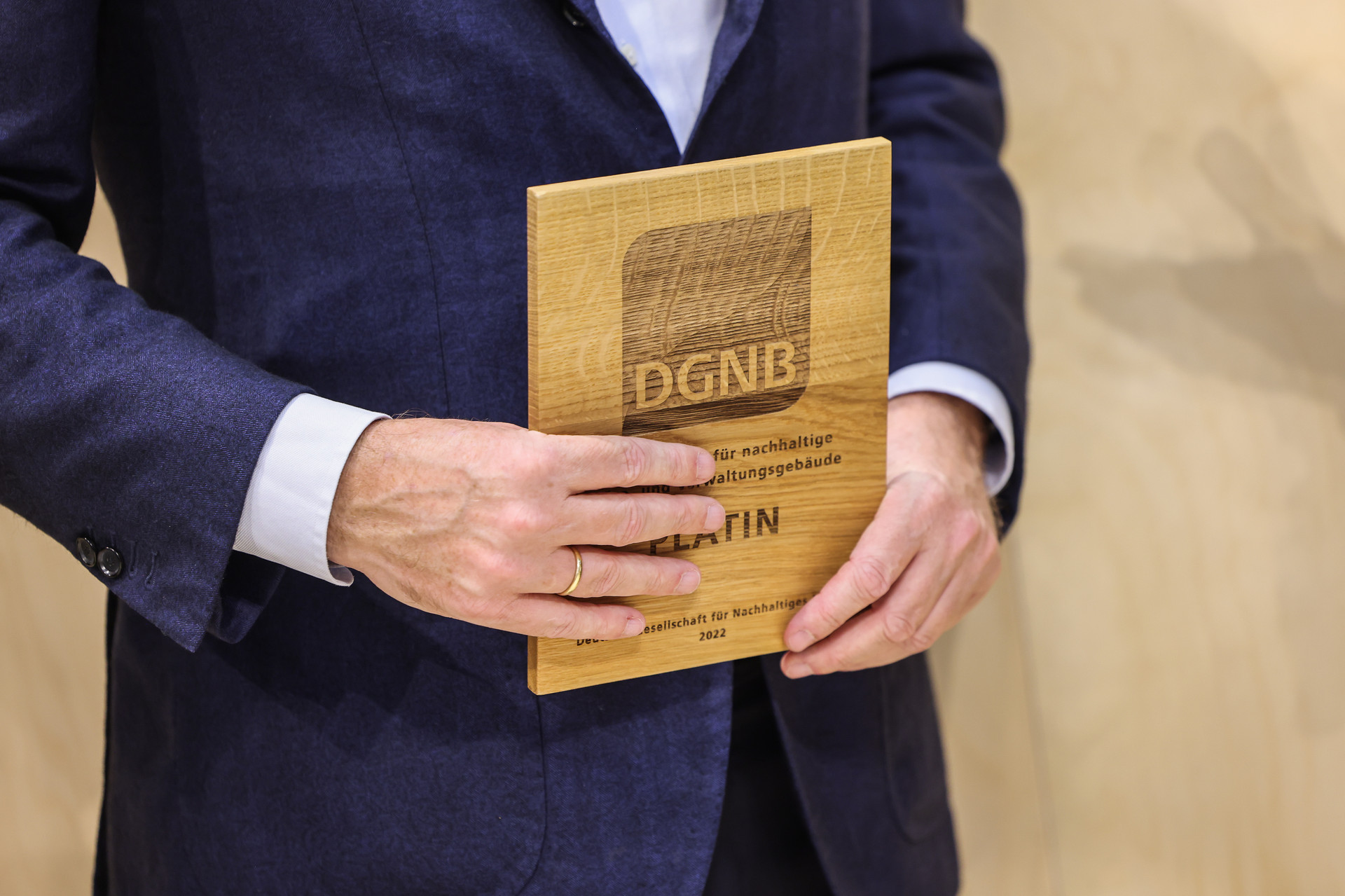Special civil engineering sites have specific requirements in terms of sustainable design and operation. In particular, the high use of construction machinery and transport vehicles means that special attention must be paid to CO2 emissions. In addition, the avoidance of waste and the conservation of resources through reuse and recycling play an important role in view of the large quantities of materials moved. The DGNB System for Sustainable Construction Sites in its special civil engineering version can provide support here as a planning and management tool. It also helps with quality assurance and risk minimisation, and sets comprehensive sustainability standards for the construction site process.
The structure of the system variant is based on the DGNB System for Sustainable Construction Sites. By integrating special requirements for the above-mentioned key issues and streamlining communication, the certification is tailored to the specific characteristics of special civil engineering projects.
For construction companies
Construction companies can submit their concept for sustainable special civil engineering sites and have it assessed and awarded as part of a basic certification. For all subsequent sites, this certification will serve as the basis for the project-specific assessment. You benefit in a number of ways:
- Employee safety
- Basic certification as a unique selling point over competitors
- Consumption data monitoring and optimisation
- Systematic improvement of existing processes
- Increased attractiveness as an employer for (new) employees
For building owners
Building owners can submit their project for certification. The benefits are many:
- Smoother construction process
- Positive image of the site (safe, clean, sustainable)
- Additional quality assurance of the construction work
- Risk minimisation through precautionary approaches
For municipalities
Municipalities have the option of making DGNB Certification a requirement, thus contributing to quality assurance at the municipal level:
- Contribution to achieving local sustainability goals
- Smoother construction process
The DGNB System does not evaluate individual measures, but the overall performance based on criteria with indicators. For special civil engineering sites, a total of four criteria are taken into account, each with a different weighting in the overall result:
- Construction site organisation | 26%
- Construction site organisation
- Measures to prevent the site from polluting the local environment
- Conservation of resources | 31%
- Energy: Conservation of resources and reduction of emissions
- Construction materials: Conserve resources and reduce emissions through reuse and recycling
- Drinking water: conserving resources
- Health and social issues 25%.
- Health prevention
- Safety - risk assessment
- Internal project communication
- Communication with the public and interested parties
- Social aspects
- Construction quality | 18%
- Construction site management
- Quality assurance of construction products
- Quality assurance of design
- As-built documentation
The criteria simultaneously address the five areas of ecology, economy, socio-cultural and functional aspects, technology and processes, thus ensuring a holistic sustainable approach. The system is currently in its initial application phase. We will be happy to send you the criteria in detail on request.
Pleaser note: The criteria are currently only available in German.
The assessment is divided into minimum requirements and variable measures. The minimum requirements consist of 18 indicators that must be met. Fulfilment of the minimum requirements accounts for 35 per cent of the maximum score.
| Criteria name | Minimum requirement (indicators) |
| Construction site organisation | all indicators |
| Resource conservation | 1.2 Use of energy-efficient construction equipment (reduction of CO2 emissions) |
| Health and social issues | 1.1 Investigations and measures for special reasons/pandemic 5.2 Organisation and documentation of site personnel 5.3 Ensuring the welfare of all participants |
| Construction quality | 1.1 Plan management 1.5 Approval, acceptance and change management 2.1 Quality Assurance of Construction Products Used - Approval List |
The other points can be achieved through variable measures. It does not matter in which of the criteria the points are achieved. The DGNB Sustainable Construction Site Certificate is awarded when a total of 65% of the criteria are met. However, it is the on-site verification of compliance that is decisive for receiving and maintaining the award for the duration of the construction project. Missing or incomplete verification will result in the award being withdrawn.
The certification of special civil engineering projects is based on the DGNB System for Construction Sites, but in contrast to the basic system, it focuses on the services or trades that can be assigned to special civil engineering.
Differences in the criteria
In contrast to the basic system, the system variant for special civil engineering comprises four instead of five criteria. The indicators for the 'Communication with the local community' criterion are included to a lesser extent in the 'Health and social issues' criterion. There are also deviations from the regular construction site certification with regard to quality assurance. For example, the number of different materials used in foundation engineering is generally lower. The avoidance of pollutants and the prevention of mould are also less important in special civil engineering projects. This is reflected in the criteria.
New indicators have also been added to the resource conservation criterion:
- 1.1 CO2 balance: This indicator covers the energy consumption and associated CO2 emissions of the construction site, as well as data on relevant transport processes and materials used.
- 2.1.1 Waste balance: The indicator provides for a waste balance according to GweAbfV § 8 para. 1. At least 80 percent of reusable or recyclable materials are reused or recycled accordingly.
- 2.2.1 Comparison of transport distance options: The indicator requires that comparisons are made of the transport distances for the delivery of materials and the disposal of waste.
- 2.3 Material / resource savings on site through alternative technologies
In terms of the weighting of the criteria, "Construction site organisation" (20% vs. 26%) and "Resource conservation" (25% vs. 31%) gain in importance.
Note: It is possible to submit a site for certification under the DGNB System for both construction sites and the special civil engineering variant. Some of the documentation required for the special civil engineering certification can be included in the construction site certification, reducing the amount of documentation required.
The certification process extends from the design of the site to its completion. The concept serves as the basis for the assessment and award of the preliminary certificate. To verify sustainability throughout the construction phase, evidence must also be submitted at regular intervals during the construction phase. The intervals between verifications depend on the duration and scope of the construction site. Evidence must be submitted at specified inspection dates in accordance with the progress of construction. The applicant receives the final DGNB Certificate upon successful completion of the construction site.
For basic certification of construction companies, all documents that can be verified in advance are submitted here. On this basis, a fixed assessment is determined as the basis for certification. The certificate is issued after the documents have been checked and the first projects have been defined. For all subsequent projects, only the project-specific documents need to be submitted during the construction phase. The implementation of the planned measures is also checked at regular intervals.
If, in addition to special civil engineering work, subsequent certification under the DGNB System for Construction Sites or the DGNB System for New Construction of Buildings is planned, there are advantages to be gained from certification. Since the criteria overlap in terms of content with the respective systems, the documentation effort for subsequent certifications is reduced.
The system is being applied to the first projects and tested for the first time. Interested parties have the opportunity to actively participate with their projects.
The DGNB System for Sustainable Construction Sites - Specialist Civil Engineering is designed to be applicable across all systems and can therefore be used for all types of building and infrastructure projects. Depending on the type of project, the following services or trades are included in the scope of certification
- (Parts of) excavations
- Retaining walls and embankments
- Sheet piling, diaphragm walls and cut-off walls
- Anchorage and bracing
- Beds
- Foundations
- Piling
- Ground improvements
- Waterproofing
- Underpinning
- Drainage, groundwater lowering
- Grouting, jet grouting
- Grouting
- Disposal works
Registration is part of the initial application process and can be done by email. Please do not hesitate to contact us. We will send you the necessary documents for registration and submission.
The documents for certification are submitted as part of the initial application by a person appointed by the building owner or, in the case of basic certification, by the building contractor who is not responsible for construction management. For example, it is recommended that a DGNB Auditor, DGNB Consultant or Health and Safety Coordinator be appointed. To ensure that the submission process runs smoothly, we will explain the content of the criteria and the form of submission in a workshop.
The evidence is submitted digitally using a tool provided by the DGNB. This is also included in the documentation we send you when you register.
Note: The audit of special civil engineering works must be notified to and agreed with the client and, as a rule, also with the owner. If the audit includes services to be provided by a consortium or subcontractors, the subcontractors concerned must be notified and agreed with in good time.


